IBDP Online Test Series By iitianacademy
Comprehensive Test Preparatory package targeted towards IBDP
Question
Outline innate and learned behaviour.
Answer/Explanation
Markscheme
innate behaviour : [3 max]
a. inherited «from parents»/controlled by genes
b. develops independently of environment
OR
not modified by experience/learning
c. species specific/shared by all members of species
d. developed by natural selection/increases chance of survival/reproduction
e. valid example of innate behaviour
Only mark the first example if more provided
learned behaviour : [3 max]
f. develops as a result of experience/environmental stimulus
g. is a process of gaining new knowledge or skills
h. not inherited «from parents»
OR
not controlled by genes
i. may or may not increase chance of survival and reproduction
j. valid example of learned behaviour
Only mark the first example if more provided
[Max 6 Marks]
Question
The diagram shows the mechanism of action of the psychoactive drug cocaine.
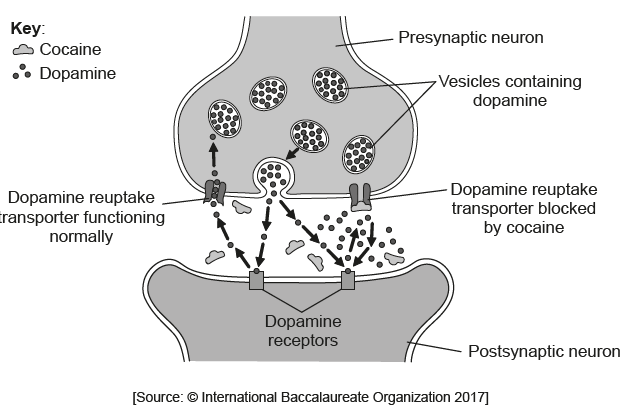
Suggest how cocaine might influence the brain.
Dopamine acts as a slow-acting neurotransmitter. Outline one function of slow-acting neurotransmitters.
Outline the structure of a reflex arc.
State the type of receptor that detects odours.
Answer/Explanation
Markscheme
a. «cocaine» is an excitatory drug OWTTE
OR
excitatory influence on the brain
b. increase the concentration/level of dopamine in the synapse OWTTE
c. prolonged effect/continuous stimulus of dopamine on the brain/postsynaptic neuron
d. addiction/dependence on high levels of dopamine for the same effect/addiction
a. they contribute to memory/learning
b. they modulate fast synaptic transmission «in the brain»
c. by causing the release of secondary messengers in the postsynaptic neuron
a. receptor cell
b. sensory neuron passes stimulus
c. to interneuron/relay neuron
d. which transmit response to motor neuron
e. effector
Award marking points for a clearly annotated diagram.
eg:
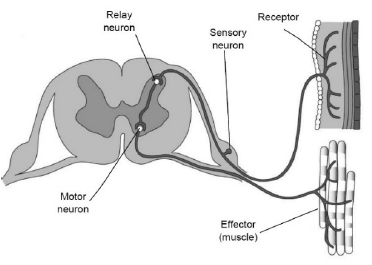
olfactory «receptor»
OR
chemoreceptor
Question
A study examined the effects of four weeks of intensive training in athletes on vertical jumping performance and neuromuscular learning. The graph shows the results for jumping height.
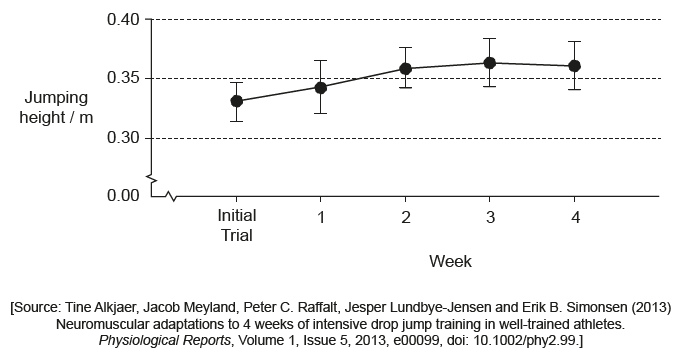
Outline the effect of training on jumping performance.
List the different types of neurons involved in a reflex arc.
Predict whether an animal such as a laboratory rat could be encouraged to learn a new behaviour pattern.
Using an example, describe how innate behaviour may increase the chances of survival of a species.
Answer/Explanation
Markscheme
a. jumping performance shows an improvement «during the first two/three weeks»
OR
no/little improvement as error bars all overlap
b. «during the period of this investigation» it reaches a plateau
c. the investigation was over a short time and is not conclusive of the effects of training over a longer period
a. sensory/afferent neuron
b. motor/efferent neuron
c. relay neuron/interneuron
Two correct for [1]
Three correct for [2]
a. operant conditioning/classical conditioning/trial and error experiences
b. behaviour could be modified by positive/negative reinforcement
c. animal makes an association between a particular behaviour and a consequence
Accept reward/punishment and/or examples such as food/electric shock.
a. innate behaviour inherited/develops independently of environment
OR
Changes in innate behaviour depend on change in frequency of alleles that cause the behaviour ✓
b. example of an innate behaviour ✓
c. description of the behaviour ✓
d. outcomes affecting survival
eg
b. synchronized oestrus in female lions
c. female lions can share responsibilities / females can suckle each other’s cubs allowing some mothers to hunt
d. cubs are more likely to survive when they are raised in a group «nursery» rather than by a solitary mother /group of male cubs can leave pride together helping each other
Question
Outline the neural control of the process of swallowing.
Describe an example of learned behaviour.
Answer/Explanation
Markscheme
a. «usually» autonomic reflex
b. «usually» involuntary/automatic
OR
not controlled consciously
c. coordinated by medulla «oblongata»
d. can be voluntary/consciously controlled «by cerebral cortex»
a. learned behaviour is behaviour that is taught or received through experience
Allow other definition.
b. named organism
eg: Chimpanzees.
Allow human, people, etc, providing it is explicitly written.
c. named/description of behaviour
eg: Sticks used to spear juicy grubs.
eg: learning a language.
Question
With respect to Pavlov’s experiments with dogs, distinguish between the conditioned and unconditioned stimulus.
The bird known as the blackcap (Sylvia atricapilla) traditionally migrates from its summer breeding grounds in Central Europe to Spain and Portugal for the winter. State two adaptive advantages of bird migration.
Outline one way in which synchronized oestrus in female lions increases the chances of survival and reproduction of offspring.
Outline one way in which neurons can be altered by memory and learning.
Answer/Explanation
Markscheme
Unconditioned stimulus triggers a response automatically/innately
Sight/smell of food «naturally» triggers salivation in dogs
Conditioned stimulus is a previously neutral stimulus «eg: sound of bell»
that becomes associated with the unconditioned stimulus «and is learned»
Triggers a conditioned response, salivation with sound before food
Award [2 max] if no reference to Pavlov’s investigation.
Food is more abundant
Temperature is more tolerable
More suitable habitat
Alternative 1
Females have their cubs/are lactating at same time
Can suckle/care for each other’s cubs while others hunt
Cubs are more likely to survive when they are raised in a nursery rather than by a solitary mother
Alternative 2
A group of male cubs, of same age, leave the pride at the same time
So can compete for dominance of another pride more effectively
Involve changes in neurons caused by slow-acting neurotransmitters
Neurons make new connections/increase number of synapses
«Short-term» memory depends on change in strength of existing neuronal connections
Long-term potentiation «LTP» is a lasting increase in strength of synaptic transmission
More receptors added to enhance synaptic transmission
Question
Synaptic density is the number of synapses per unit volume. The graph shows the synaptic density for a 28-week-old fetus, and from birth to age 70.
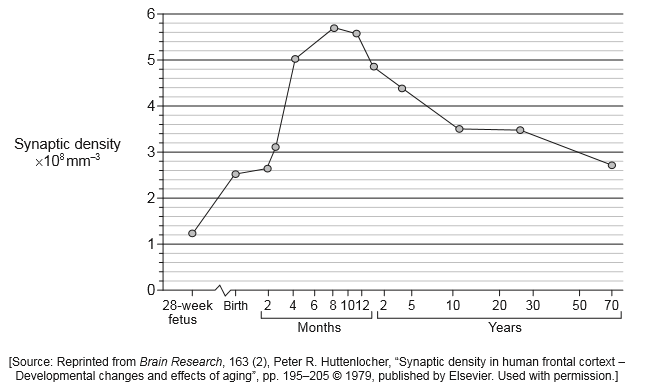
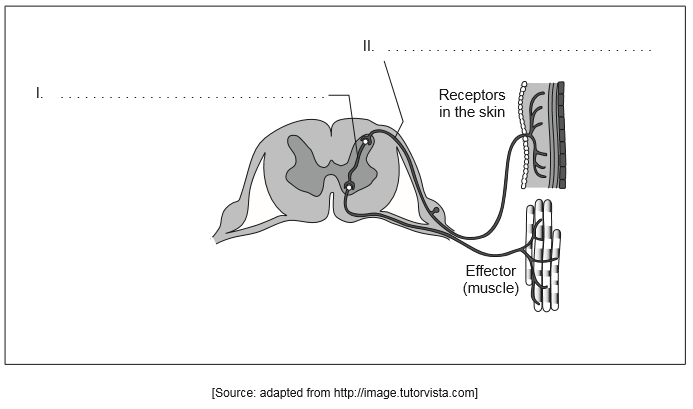
(i) Determine the age when synaptic density is highest.
(ii) Explain how synaptic density decreases after the age determined in (a)(i).
Label the diagram of the reflex arc with the names of the neurons indicated.
Draw an arrow on the diagram of the reflex arc to show the direction of impulses.
Answer/Explanation
Markscheme
(i) 8 months
(ii) Neural pruning
OR
loss of neurons
Through apoptosis/programmed cell death
Loss of dendrites/axon branches/synapse elimination
Due to lack of use
«In older age» damage to brain/strokes/chemical abuse
I: interneuron/relay neuron
II: sensory neuron
Arrow drawn on diagram to show correct direction of impulse
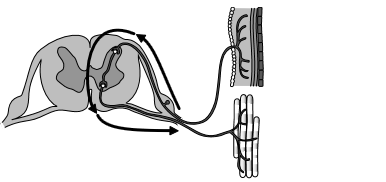
Arrow can also be a single loop through interneuron showing complete pathway or two arrows to and from interneuron.
Question
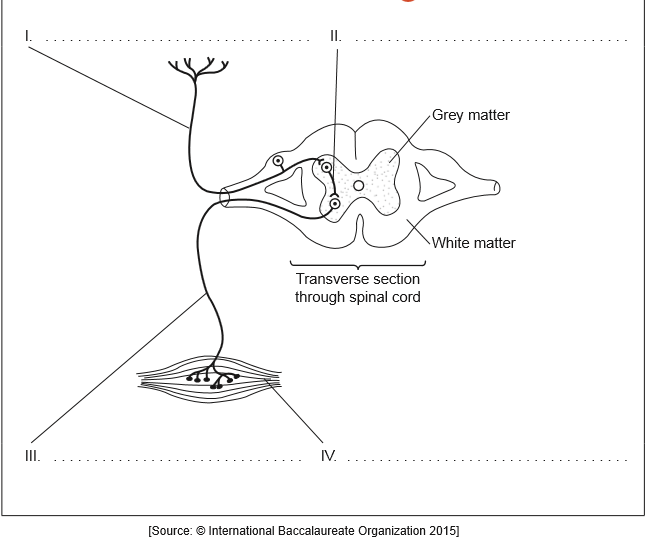
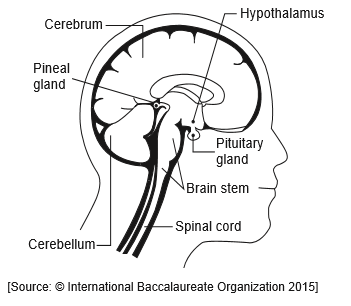
Label the numbered parts of the reflex arc.
State the type of human sensory receptor that detects motion, gravity and stretch.
State the part of the brain responsible for coordination and balance, especially during athletic competition such as the Olympics.
Outline control of heart rate by the medulla oblongata.
Answer/Explanation
Markscheme
Award [1] for every two correct up to [2 max].
I: sensory/afferent neuron;
II: interneuron/relay neuron;
III: motor/efferent neuron;
IV: effector/muscle;
mechanoreceptor
cerebellum
a. (autonomic nerve signals from medulla oblongata) can override pacemaker;
b. parasympathetic stimulation decreases heart rate;
c. parasympathetic/vagus nerve runs from the medulla oblongata to the heart;
d. sympathetic nerves from medulla (travel down spinal cord where) synapse with other nerves before going to heart;
Question
Honey bees (Apis mellifera) were fed with sucrose solution only or with low doses of ethanol in sucrose solution to examine how a slightly intoxicated state could affect their behaviour. Individual behaviour involves walking and grooming while social behaviour includes contact of antennae between bees to show recognition (antennation) and asking other bees for food when hungry (begging). The graphs show individual and social behaviour changes observed in successive five minute intervals two hours after honey bees were fed sucrose solution either with or without ethanol.
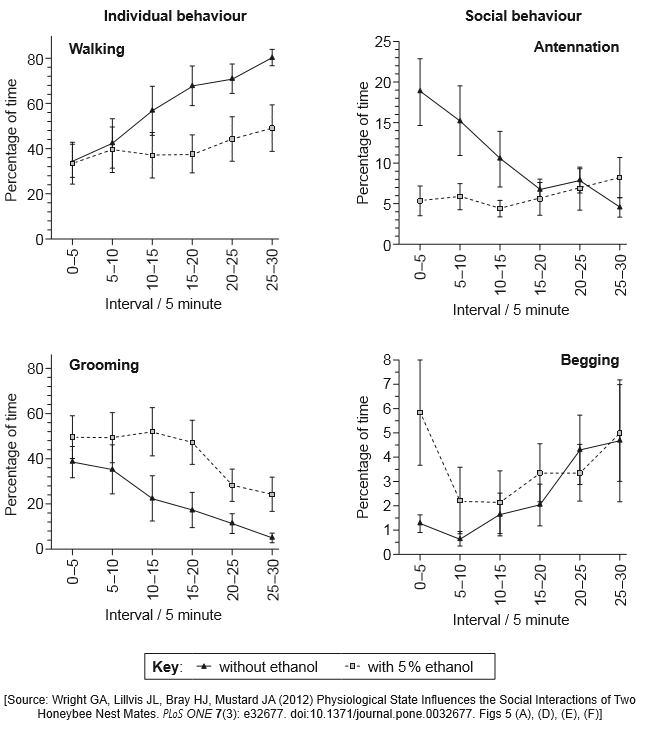
State the percentage of time the honey bees engaged in begging during the first five minute interval.
Bees fed with ethanol: …………………%
Bees fed without ethanol: …………………%
Describe the trends in antennation for honey bees fed with ethanol and without ethanol.
Distinguish between the times spent walking and grooming for honey bees fed with ethanol and without ethanol.
Evaluate the hypothesis that ethanol affects the social behaviour of honey bees.
Answer/Explanation
Markscheme
bees fed with ethanol:
5.9 (%); (allow answers in the range of 5.8 (%) to 6.0 (%))
bees fed without ethanol:
1.3 (%); (allow answers in the range of 1.2 (%) to 1.4 (%))
(both needed)
a. without alcohol (antennation starts at a high level and) decreases with time;
b. with alcohol, the value (starts low and) very slowly increases;
c. the values of both groups become very similar with time;
a. (time spent) walking is greater in bees without alcohol (than alcohol);
b. (time spent) grooming is greater with alcohol (than without alcohol);
c. the end point difference is greater in walking;
d. (time spent) walking increases whereas grooming decreases for both groups of bees;
a. (hypothesis is supported as) alcohol decreases antennation at the start of the experiment;
b. (hypothesis is supported as) alcohol increases begging at the start;
c. begging time is more variable/less significant differences with alcohol (so less clear than in antennation);
d. (hypothesis is supported as) the effect of alcohol on social behaviors becomes less distinguishable over time (with the effect of sucrose) / OWTTE;
Question
State one excitatory and one inhibitory psychoactive drug.
Excitatory: ……………………………………………………
Inhibitory: ……………………………………………………
Describe, using one specific example of an animal, how the process of learning can improve its chances of survival and reproduction.
Answer/Explanation
Markscheme
a. excitatory: nicotine / cocaine / amphetamines / other drugs;
b. inhibitory: benzodiazepines / alcohol / THC / other drugs;
a. named animal;
b. description of learned action allowing a more flexible response that improves health/survival/reproduction;
eg:
a. chimpanzees;
b. poking sticks in the wood increases chances to get more food/termites/insects;
a. blue jays;
b. avoidance of certain bad taste / poisonous insects prevents them from being sick/poisoned;
a. hedgehogs;
b. running across roads instead of rolling up when vehicles approach more likely prevents them from being killed;
Accept any other verifiable examples.
Question
The diagram shows the procedure used by Pavlov during his experiment on dogs.
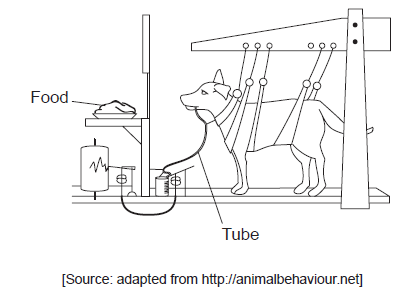
State the type of stimulus provided by the sight and smell of the food.
State the function of the tube.
State two effects presynaptic neurons could have on postsynaptic transmission.
Answer/Explanation
Markscheme
unconditioned (stimulus)
to collect the saliva (for measurement of volume)
excitation and inhibition
Question
European robins (Erithacus rubecula) migrate South in the autumn (fall) and North in the spring. They orient their direction of flight using the local magnetic field, which they detect through magnetoreceptors in the upper beak. The orientation of the birds in a captive environment was studied in spring and autumn, which are the times of year when the birds normally migrate. The response of the birds to green light, red light and total darkness was investigated. Triangles on the edge of circles indicate the mean direction flown by individual birds while the arrows indicate the overall mean direction of flight.
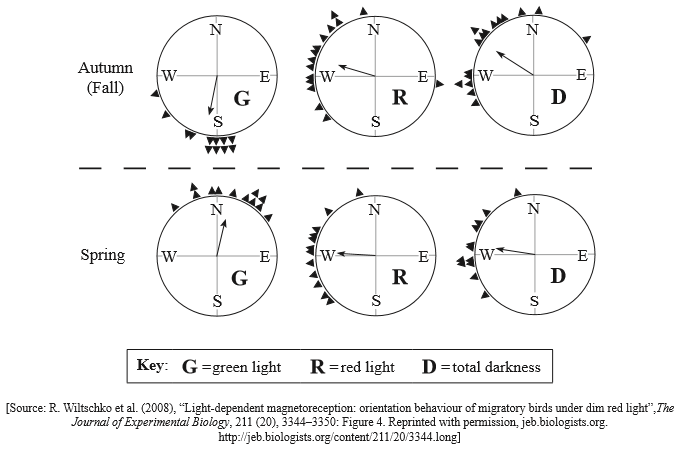
Identify the season and light conditions which result in the strongest northerly direction flown by the robins.
Season:
Light conditions:
Distinguish between the effect of red light and green light on the behaviour of the robins in spring and autumn (fall).
Based on the results of these experiments, suggest one possible conclusion that could be drawn regarding the effect of red light on the behaviour of robins.
Using the data in the diagram, deduce with a reason, whether European robins migrate during the daytime or at night.
Scientists anesthetized the beaks of some robins in order to deactivate the magnetoreceptors. Predict how this would affect their orientation in red light.
Answer/Explanation
Markscheme
spring, green light
Both required for [1].
a. in green light birds migrate North in spring but South in autumn;
b. in red light birds orientate (North) West in both autumn and spring;
a. in red light birds do not migrate in the normal pattern/direction;
b. red light disorientates the birds/interferes with the functioning of magnetoreceptors;
c. red light has (almost) the same effect as total darkness / birds do not see in red light;
a. during daytime;
b. direction of migration is not normal/wrong orientation in darkness;
a. no effect;
b. may become (even) more random;
Question
Define the term stimulus.
Outline the functions of the following parts of the brain.
Medulla oblongata:
Outline the functions of the following parts of the brain.
Hypothalamus:
Explain the effects of psychoactive drugs on synaptic transmission.
Outline how endorphins act as painkillers.
Answer/Explanation
Markscheme
stimulus is a change in the (internal/external) environment that can be detected
medulla oblongata: controls autonomic functions of the body such as heart rate/blood pressure/ventilation/swallowing/vomiting/digestion/cranial reflexes
hypothalamus: links nervous and endocrine systems/produces hormones secreted by posterior pituitary/controls hormonal secretion by pituitary/maintains homeostasis such as control of body temperature/hunger/thirst/fatigue/circadian cycles
psychoactive drugs may increase or decrease transmission (to the post-synaptic membrane);
may increase the release/delay the breakdown/interfere with storage/uptake/reabsorption of neurotransmitters;
may mimic the action of neurotransmitters;
inhibitory drugs may reduce the effect of excitatory neurotransmitters/increase the effect/release of inhibitory neurotransmitters;
inhibitory drugs can hyperpolarize the post-synaptic neuron;
endorphins released by pituitary gland (during stress, injury or exercise);
endorphins block transmission of impulses at synapses involved in pain perception;
bind to receptors in the membrane neurons (involved in) sending pain signal;
block release of neurotransmitters;
Question
Distinguish between innate and learned behaviour.
Distinguish between analogous and homologous structures.
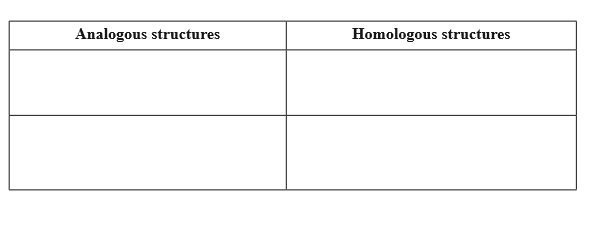
Answer/Explanation
Markscheme
innate behaviour is independent of experience/environmental conditions/inherited
while learned behaviour is influenced by experience/environment / OWTTE

Question
Each spring, the breeding season for various species of toads begins with a mass arrival of females at ponds and lakes. Males arrive later and actively compete for the females. Amplexus (mating embrace) and spawning (depositing eggs in water) then follow. Many environmental variables affect the timing of breeding. The hypothesis that periodicity in reproductive behaviour reflects periodicity in the lunar cycle was tested over several breeding seasons at sites in Wales (UK) and Italy. The lengths of the shaded bars indicate the relative frequencies of the events.
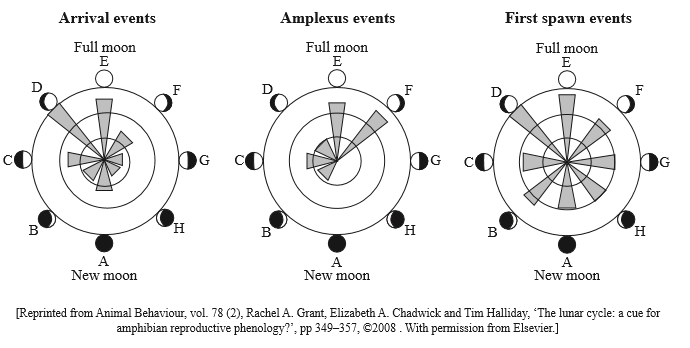
Identify which reproductive event is least influenced by the lunar cycle.
Compare the data for arrival events with amplexus events.
Deduce the relationship between arrival events and amplexus events in moon phases D to F.
The lunar cycle could affect the timing of breeding. Suggest, with a reason, one other environmental variable which could affect the timing.
Answer/Explanation
Markscheme
first spawn/spawning
frequency at full moon/E about the same;
both arrival (event) and amplexus (event) have low/similar frequencies in B and C;
highest frequency for arrival (event) in D whereas highest frequency for amplexus (event) in F;
always some arrivals but amplexus (event) only in B to F / no amplexus (event) in G/H/A;
mass arrival (events) at phases D and E is followed by large amplexus (events) at phases E and F;
full moon/lunar cycle seems to influence timing of both events (in sequence) / OWTTE;
example of environmental condition;
reason for the example;
e.g.:
rainfall;
necessary to maintain pond levels to enable the toads to spawn;
temperature / season / daylength;
affects metabolism / survival of offspring;
Question
Desert ants (Cataglyphis fortis) use odour to help find their food. When a constant wind is blowing, the ants do not approach food directly. Instead, they walk downwind of the food source and then, when they detect the odour of the food, they follow the odour trail upwind until they reach the food, as shown in the figure below.
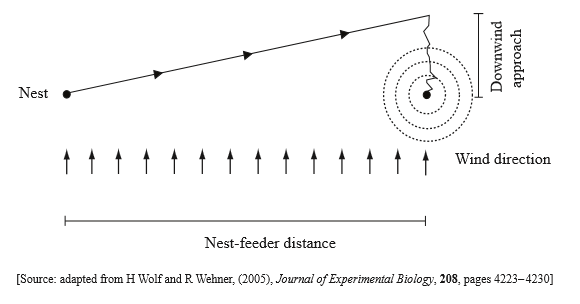
To investigate this behaviour pattern, feeders were established at distances of 5 m to 60 m away from the nest. Each feeder consisted of a Petri dish filled with biscuit crumbs. The graph below shows the distribution of downwind approach distances for each different nest-feeder distance.
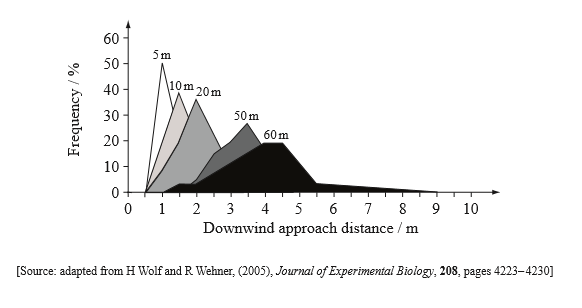
Outline the relationship between the downwind approach distance and the nest-feeder distance.
Compare the results observed when the feeders were located at 5 m with the feeders at 60 m.
Suggest one possible source of uncertainties or errors in these experiments.
Deduce, with a reason, what type of behaviour pattern is shown by the ants in the experiment.
Answer/Explanation
Markscheme
downwind approach distance increases with increasing nest-feeder distances / the closer the feeder to the nest the shorter the downwind approach distance / direct/positive relationship
feeder at 5 m has smaller downwind approach distances than feeder at 60 m / vice versa;
feeder at 5 m has peak frequency at 50 % whereas at 60 m peak/plateau at 20 %;
narrower range of approach distances for 5 m while wider range of approach distances for 60 m;
feeder at 5 m has peak approach distance at 1 m downwind while feeder at 60 m has peak/plateau 4 m – 4.5 m;
difficulty handling ants / size of ants;
variation of wind;
other odours;
path of trail not easy to measure accurately;
Accept any other reasonable suggestions.
EITHER
innate behaviour / taxis;
because all walking at same angle to constant wind / all turn and follow odour trail when they detect smell;
OR
learned behaviour;
because of repetition/training / following other ants;
Question
The following diagram shows a section through the spinal cord.
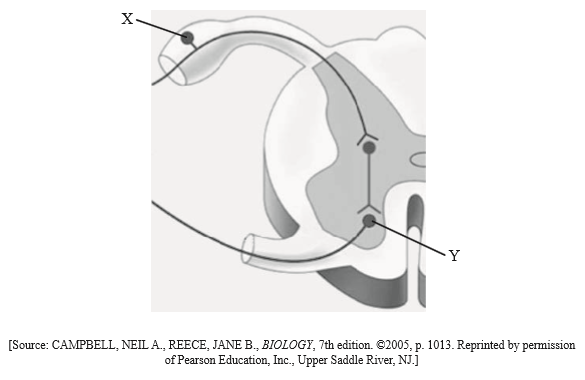
Outline one function for each of the following parts of the brain.

Label cells X and Y.
X: …………………………………………………….
Y: …………………………………………………….
Outline the direction of nerve impulses through the cells labelled X and Y.
Define the term reflex.
State whether the following psychoactive drugs are excitatory or inhibitory, using the table below.
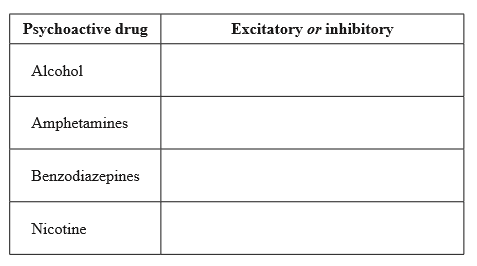
Answer/Explanation
Markscheme

X: (cell body of) sensory neuron;
Y: (cell body of) motor neuron;
(both needed)
from the sensory neuron/X to the motor neuron/Y
a rapid and unconscious response (to a stimulus / of the nervous system)
Award [1] for every two correct responses.
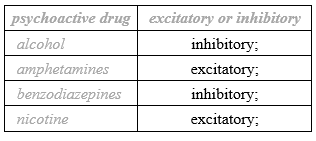
Question
In order to investigate the hypothesis that honeybees (Apis mellifera) have an instinct to forage for either nectar or pollen, but not both, researchers installed different feeders containing either nectar alone or pollen alone. They collected four different groups of honeybees (those arriving at the nectar feeders, arriving at the pollen feeders, departing from the nectar feeders and departing from the pollen feeders) and measured the abundance of eight peptides in their brains. The relative difference of these brain peptides was then calculated by subtracting the abundance in nectar foragers from the abundance in pollen foragers and is shown by the bars on the graphs below.
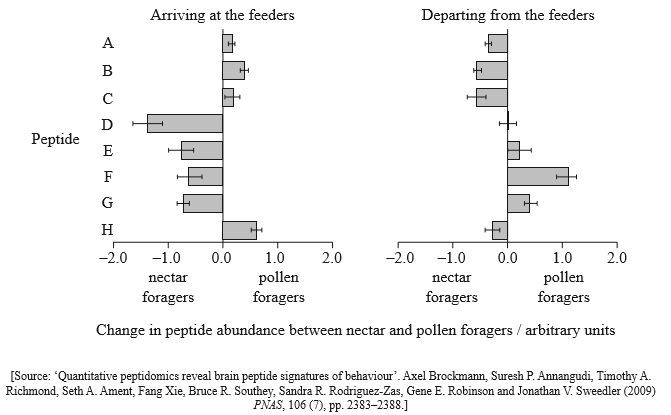
Identify which peptide shows the greatest difference between pollen foragers and nectar foragers departing from the feeders.
Distinguish between the difference in abundance of peptides in nectar and pollen foragers arriving at the feeders.
Evaluate the hypothesis that honeybees have an instinct to forage for either nectar or pollen, but not both.
Discuss how this type of foraging behaviour could optimize food intake.
Answer/Explanation
Markscheme
(peptide) F
(peptides) A, B, C and H more abundant in pollen foragers;
(peptides) D, E, F and G more abundant in nectar foragers;
greater abundance (differences) for nectar foragers;
A and C showed little difference;
Do not accept numerical statements only.
(arguments supporting the hypothesis)
each group of foragers is always associated with the same group of peptides;
trends inverse between nectar (foragers) and pollen (foragers)/arriving and departing / OWTTE;
error bars on the graph show that the differences are likely to be significant;
(arguments not supporting the hypothesis)
no data about nectar/pollen actually collected / sample size;
there is no evidence of causation/that the peptide in the brain is determining the type of foraging itself;
(predisposition/instinct/natural selection) ensures that both pollen and nectar will be collected;
allows the bees to collect whichever food source is in abundance at the time / increases food collection efficiency;
both pollen and nectar are diet requirements;
this behaviour is part of division of labour/specialization;
Question
Explain the role of the neurons used in the pain withdrawal reflex.
State one effect of tetrahydrocannabinol (THC) on brain function.
Answer/Explanation
Markscheme
sensory neurons receive information from receptors;
transmit nervous impulses to the central nervous system;
relay neurons in the central nervous system transmit the information from sensory neurons to motor neurons;
motor neurons send impulse to effector;
inhibition of nervous impulses / binding to cannabinoid receptors / blocking of release of excitatory neurotransmitter
Question
Corals can be male, female or hermaphrodite (both male and female) and the release of their gametes is called spawning. Data was collected to study the spawning behaviour in the Gulf of Mexico of three genera of coral: Montastraea, Stephanocoenia and Diploria. The spawning behaviour is expressed in minutes post-sunset. Peak spawning windows are shown as grey bars and the range as black bars.
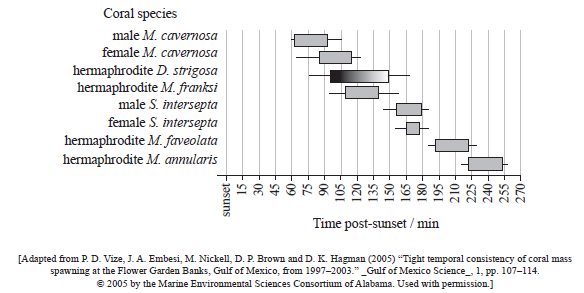
Suggest why it may be advantageous for each species of coral to spawn within a tight time frame.
Discuss the significance of different spawning windows for different species.
Scientists hypothesized that the release of the male gamete triggers a chemical signal for females to release their eggs. Discuss this hypothesis.
The spawning window of D. strigosa is shown as a shaded gradient indicating a strong bias towards spawning in the early portion of the window. Suggest a reason for the spawning behaviour of D. strigosa.
Define the term innate behaviour.
Answer/Explanation
Markscheme
to increase the possibilities of fertilization
a. to avoid interspecific/cross-fertilization;
b. cross-fertilization usually not successful/non-productive;
c. some overlap of species spawning occurs so temporal separation is not completely successful;
d. example of overlap (e.g. D. strigosa overlaps with M. cavernosa/M. franksi);
a. females always spawned after males suggesting hypothesis correct;
b. for example in M. cavernosa or S. intercepta;
c. difficult to tell for hermaphrodites;
d. chemical analysis of water should be undertaken after males spawned / other chemical signals / further evidence required to support cause and effect;
a. the spawning of D. strigosa is influenced by male M. cavernosa;
b. the spawning of D. strigosa is influenced by the release of M. franksi;
c. D. strigosa spawning diminishes due to the appearance (spawning) of M. franksi;
d. light intensity determined;
innate behaviour develops independently of the environmental context / not learned/ stereotyped / inherited / genetic pre-disposition
Do not accept instinct.
